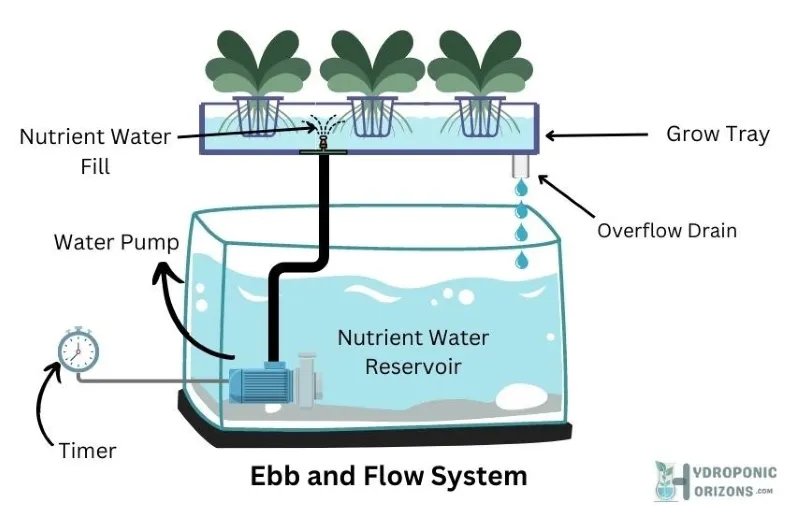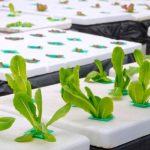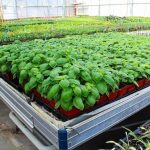Ebb and Flow Hydroponics, also known as Flood and Drain systems, are an innovative and effective way to grow plants without the need for soil. In this method, the plants are perched on a growing medium such as gravel, clay pellets, or lava rock. Periodic flooding and draining of nutrient-rich water nourishes the plants, giving them the benefits of both hydration and aeration.
We have found that DIY Ebb and Flow hydroponic systems can be designed for various applications, whether large or small-scale growth. They provide flexibility for gardeners to utilize their creativity while cultivating a wide range of plants. In the world of hydroponic gardening, it is one of the most popular growing methods for its efficiency, customizability, and ease of construction. You can choose either the dutch bucket system or the trough system.

In this article, we will explore the essentials for building your own ebb and flow hydroponic trough system, the critical components required, and some tips for maintaining and maximizing plant growth in these unique gardens. We have a separate guide to building an ebb and flow bucket system. Get ready to discover a smarter and cleaner way to nurture your plants and bring your hydroponic garden to life!
Planning Your Ebb and Flow System
Components and Materials Required
For a successful Ebb and Flow Hydroponics DIY system, we will need the following components and materials:
- Flood tray (also known as a plant tray or grow tray) – a large, shallow container to hold the plant pots
- Net pots or mesh containers filled with a growing medium such as Perlite, which helps support the plants and allows root aeration
- Reservoir tank to store nutrient-rich water
- Submersible water pump to flood trays with nutrients and water
- Optional air pump and air stones to oxygenate the nutrient solution
- Pump timer to control the flooding and draining cycles
- Tubing for water delivery and drainage
- Nutrients for mixing with water in the reservoir
- Overflow tube or pipe to manage excess water
Homemade Ebb And Flow Hydroponic System Design and Layout
When designing our Ebb and Flow hydroponics system, the first step is to determine the layout of the components.

- Tray height: Position the flood tray on a tall stand or suspend it to allow adequate space for the reservoir tank and drainage underneath.
- Reservoir placement: The reservoir tank should be located directly below the flood tray to receive drained water and simplify the system’s plumbing.
- Water pump and tubing: Set up the submersible water pump inside the reservoir and connect it to the flood tray using durable tubing. Attach a fill tube for flooding and a drain tube for draining. Ensure that the pump timer is connected to the water pump to automate the flooding and draining cycles.
- Optional air pump and air stones: Place the air pump outside the reservoir, connecting it to air stones inside the reservoir via tubing. This setup will help oxygenate the nutrient solution, promoting healthy root growth and preventing algae growth. Note that if you use a growing medium that is known for excellent aeration, you may not need to provide this extra oxygenation, as the roots will be allowed to dry during the draining cycle.
- Overflow protection: Install an overflow tube or pipe in the flood tray to prevent over-flooding and ensure proper drainage.
- Growing medium and plants: Place net pots or mesh containers filled with Perlite or another suitable medium on the flood tray. Space the pots evenly to allow ample room for plant growth and to prevent crowding.
- Flood and drain timing: Set appropriate flood and drain times on the pump timer according to the stage of plant growth and the Ebb and Flow hydroponics DIY system’s design.
By carefully considering these aspects, we can create a versatile, efficient, and effective ebb and flow hydroponic setup tailored to our specific needs.
Related: Not sure about how Ebb and Flow hydroponics works? Then read our extensive guide before building your system.
DIY Ebb and Flow Hydroponic System
In this section, we’ll provide a step-by-step guide to building your own Ebb and Flow hydroponic system using the components and design laid out above.
Step-by-Step Guide: How To Build An Ebb And Flow Hydroponic System
1. Gathering materials: Before we begin, let’s gather all the necessary materials for our ebb and flow setup. We’ll need a reservoir, a tray or container for the plants, a submersible water pump, an air pump (this is optional but recommended), a digital or analog timer, some black tubing (about 20ft of 1/2 inch tubing), and mesh pots or net cups for the plants.
2. Assembling the reservoir and tray: Place the tray or container on top of the reservoir. Make sure it’s stable and level to avoid any water discrepancies during the ebb and flow cycles. It’s important to choose a reservoir and tray that will not allow light to penetrate, as this can encourage the growth of algae.
3. Attaching the water pump and tubing: Install the submersible water pump in the reservoir, ensuring it’s properly submerged in the water. Connect the black tubing to the pump, and run it from the pump to the tray, securing it in place at the tray.
4. Setting up the timer: Connect the water pump and the optional air pump to the timer, ensuring it covers a 24-hour cycle. You’ll want to set the timer to flood and drain the plants’ roots at a suitable schedule (generally, flooding 3-4 times a day for 15-30 minutes at a time works well). Get more details about perfecting your ebb and flow hydroponics cycle time.
5. Placing the plants: Put your plants in the mesh pots or net cups, making sure the roots are well encased. Place the pots in the tray, evenly spaced to allow for good airflow and light distribution.
6. Filling the reservoir and beginning the cycle: Fill the reservoir with water and nutrient solution, ensuring it reaches the appropriate level. Turn on the water pump and set the timer for the ebb and flow cycle that works best for your plants. Make sure to monitor the system closely for the first few days, adjusting the timer and nutrient levels as needed to ensure optimal growth.

By following these steps, we can create an efficient Ebb and Flow hydroponic system to grow healthy and strong plants. Remember to maintain proper hygiene and control algae growth by periodically cleaning the system, and be sure to observe your plants for any signs of stress or nutrient deficiencies to address them promptly.
Using an Ebb And Flow Hydroponics Kit
When it comes to setting up an Ebb and Flow hydroponic system, one of the easiest ways to get started is by purchasing a complete kit. These kits come with everything you need to get your system up and running, including a reservoir, pump, timer, grow tray, and growing medium. While it’s certainly possible to build your own system using individual components, buying a complete kit offers a number of benefits that make it a convenient and fail-safe option.
One of the biggest advantages of buying a complete Ebb and Flow hydroponics kit is the convenience it offers. With a kit, you don’t have to spend time researching and sourcing individual components and then using tools to put everything together. Instead, everything you need is included in one package, making it easy to get started right away. This can be especially helpful for beginners who may not be familiar with the different components and how they work together.
While it’s true that you may be able to save money by building your own system that you intend to scale up, this often requires a significant amount of time and effort. Additionally, you may end up spending more money in the long run if you make mistakes or need to replace components that don’t work as expected. With a ebb and flow kit, you can be confident that all of the components are designed to work together and that you’re getting the best value for your money. You can always expand your setup with a DIY build once you’re confident about operating the initial system.
Overall, if you’re looking to set up an Ebb and Flow hydroponic system, buying a complete kit can be a smart choice. Not only does it offer convenience, but it also ensures that you have all of the components you need to get started quickly and easily. So if you’re a beginner, consider investing in a complete kit to make your hydroponic journey a success.
Related: Choose from our picks of the best ebb and flow hydroponic system kits!
System Maintenance and Troubleshooting
Routine Maintenance
As a part of our ebb and flow hydroponic system maintenance, we need to ensure that the system operates smoothly and the plants grow healthy. Fortunately, among ebb and flow hydroponics pros and cons, a big pro is that this system is one of the easiest to maintain. Here are some essential tasks we have to perform regularly:
- Cleaning: We need to clean the growing trays, reservoir, and tubing regularly to prevent algae or bacterial growth. This helps keep the system healthy and prevents any unwanted infections in our plants.
- Checking pH levels: Maintaining the ideal pH level is essential for our plants’ successful growth. We should monitor the pH levels of the nutrient solution and adjust it by adding pH stabilizers whenever necessary.
- Monitoring drainage: We must ensure that the system drains out the nutrient solution properly after each flood cycle. Check the drainage tubes and inspect for possible clogs or leaks to ensure the plants get an adequate amount of nutrients and oxygen.
- Maintaining oxygen level: We should also monitor the oxygen levels in our nutrient solution. One way to maintain the proper oxygen levels is by utilizing air stones that can help dissolve oxygen within the nutrient solution.
Common Issues and Solutions
As you work with your ebb and flow setup, you may encounter some common problems. Here are some issues you might face and their solutions:
- Uneven flooding: If your system features uneven flooding during the flood cycle, you may need to adjust the heights of your growing trays or the location of the fill/drain fittings.
- Clogged tubes: Clogged tubes could lead to poor nutrient circulation and drainage problems. It is vital for you to clean the tubes regularly and use filters or screens to prevent debris from entering the system.
- Algae growth: Algae growth can occur on the surface of the nutrient solution and on the growing media. To avoid this, we have to keep the growing area clean and avoid exposure of the nutrient solution to sunlight. Adding a cover to the reservoir can help minimize light exposure and algae growth.
- Root rot: Root rot could be a result of insufficient oxygen levels in the nutrient solution or improper drainage. Ensuring proper drainage and maintaining adequate oxygen levels in the nutrient solution can help prevent root rot. If you didn’t add an air pump and air stones to your setup, then adding it now should get rid of the problem.
By diligently performing routine maintenance and addressing common issues, we can help our ebb and flow hydroponic setup thrive and support healthy plant growth.







